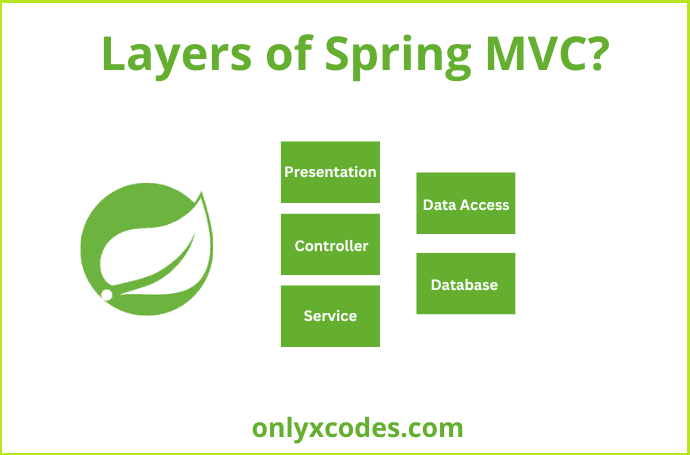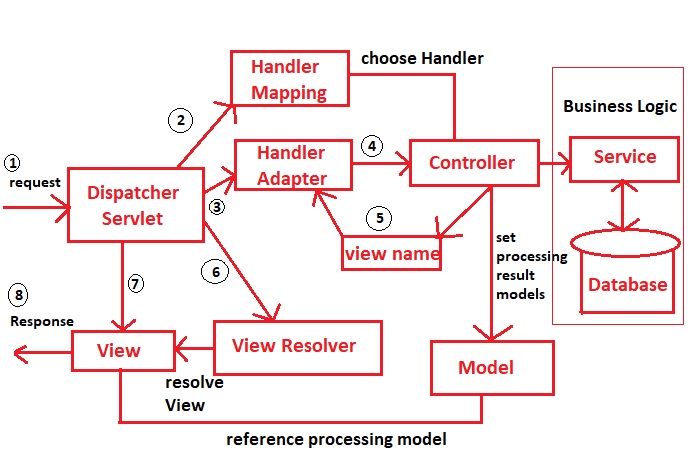Java developers frequently use the Spring MVC framework to create web apps. For creating web applications, it offers a model-view-controller (MVC) architecture.
The functionality required for a web application is provided by the layers that make up this architecture.
In this article, we will explore the layers of Spring MVC and explain how they work together to provide the necessary functionality.
Table Content
1. What is Layered Architecture?
2. Advantages Layered Architecture
3. Layers of Spring MVC
4. How the Layers Work Together
5. Advantages of using Layers in Spring MVC
6. Conclusion
What is Layered Architecture?
A method for separating a software application into layers or components is called layered architecture.
Each layer interacts with the layers above and below it and is responsible for a certain set of functionalities. This method has a number of benefits, including scalability, ease of maintenance, and concern separation.
Advantages Layered Architecture
There are several advantages of using a layered architecture:
Separation of Concerns: By splitting an application into layers, each layer can concentrate on a particular set of tasks, decreasing complexity and making the application easier to maintain and alter.
Modular Design: Each layer of layered architecture can be constructed independently, allowing for a modular design. This makes it simpler to test and debug each layer independently, as well as to add or delete functionality.
Reusability: Each layer can be utilized in other projects or applications, which minimizes the amount of new code that must be written.
Scalability: By adding additional instances of a specific layer as needed, a layered architecture enables an application to scale horizontally. This makes it more likely that the program will be able to handle more users or tasks.
Security: A layered architecture can increase the security of an application by enforcing access controls between layers and moving sensitive data or operations into a separate layer.
Layers of Spring MVC
The Spring MVC architecture consists of the following layers:
Presentation Layer
The user interface and handling of user input are handled by the Presentation Layer.
This makes from elements like CSS (Cascading Style Sheets) files, HTML pages, and JSP (JavaServer Pages) files. These parts are responsible for managing user interactions and rendering the user interface.
Controller Layer
Requests from the user are received by the Controller Layer, which then assigns them to the proper service or component.
That makes from elements like controllers, which are responsible for managing requests and producing responses.
Between the Presentation Layer and the Service Layer, the Controller Layer serves as a bridge.
Service Layer
Implementing the application's business logic is the responsibility of the service layer.
This builds from parts like services and managers that are in charge of processing data and giving the application functionality.
Between the Controller Layer and the Data Access Layer, the Service Layer serves as an interface.
Data Access Layer
Data storage and retrieval from the database are the responsibilities of the Data Access Layer.
That develops from parts like DAOs (Data Access Objects), which are in charge of carrying out database operations.
From the Service Layer and the Database Layer, the Data Access Layer serves as a connection.
Database Layer
Data storage and retrieval from the database are the responsibilities of the database layer.
The database itself and the database management system (DBMS) make up this system.
The simplest component in the Spring MVC architecture, the Database Layer, is in charge of interfacing with the actual data storage.
How the Layers Work Together
A reliable architecture is offered by Spring MVC for creating web apps. We'll examine Spring MVC's many layers and describe how they interact to build a complete web application.
Front Controller
One controller is in charge of managing each request made to the program, which is how the Front Controller design pattern is used in online applications.
The DispatcherServlet implements the Front Controller in the Spring MVC framework. It is responsible for handling all incoming HTTP requests and delegating them to the appropriate handlers within the application.
When a request is received, the DispatcherServlet uses a set of rules to determine which controller or handler should be responsible for handling the request.
Handler Mapping
Incoming requests are mapped to the relevant Controller through Handler Mapping.
BeanNameUrlHandlerMapping, ControllerClassNameHandlerMapping, and RequestMappingHandlerMapping are just a few of the different forms of Handler Mapping that are accessible in Spring MVC.
Controller
Handling user input and updating the Model and View as necessary falls under the management of the Controller.
Controllers in Spring MVC are Java programs that process requests and provide back a ModelAndView object. The data to be shown and information about the view that will be rendered are both contained in the ModelAndView object.
Model
The Model represents the application's data and business logic.
In Spring MVC, a JavaBean, a straightforward Java object with getters and setters for its properties, is typically used to represent the model.
The Model is used by the View to display information to the user, and the Controller changes the Model with new data.
View
Data presentation to the user is the responsibility of the View.
JSP View and Thymeleaf View are two of the many types of Views that are accessible in Spring MVC.
The View takes information from the Model and renders it into HTML before sending it back to the user's browser.
Advantages of using Layers in Spring MVC
See the advantages of using layers in Spring MVC below and how they contribute to the creation of high-quality, maintainable web applications.
Separation of Concerns
The separation of concerns is a key benefit of layers in Spring MVC.
Each layer performs its own duties without interfering with those of the other layers. As a result, the code is easier to maintain and more modular.
For instance, you can alter the data storage system without affecting the other layers if you simply change the Data Access layer.
Reusability of Code
The use of layers in Spring MVC encourages code reuse.
Multiple Controllers may use the Service layer, and numerous Service classes may use the Data Access layer.
This prevents code duplication and encourages the development ethic known as DRY (Don't Repeat Yourself).
Testability
The code is more testable in Spring MVC when layers are used. Unit tests can be used to independently test each layer.
By simulating the Data Access layer, for instance, you may test the Service layer and ensure that the business logic behaves as expected. As a result, bugs are simpler to find and address early in the development process.
Scalability
The code in Spring MVC is more scalable because of layers. More Controllers or Services can be added without having an impact on the other layers. You can scale your application as your business expands thanks to this.
Easy Maintenance
The code is easier to maintain when using layers in Spring MVC. Each layer is in charge of its own duties and can be changed or removed without impacting the others.
This facilitates the addition of new features and the fixing of issues without resulting in unneeded impacts.
Conclusion
In conclusion, Spring MVC offers a reliable architecture for creating web apps.
The Front Controller pattern handles incoming requests, the Handler Mapping chooses which Controller to use, the Controller updates the Model and View, the Model stores the application's data and business logic, and the View renders the HTML output for the user. These layers of Spring MVC work together to create a complete web application.
It's critical to comprehend the various Spring MVC layers in order to create scalable and maintainable web applications.








.png)


No comments:
Post a Comment